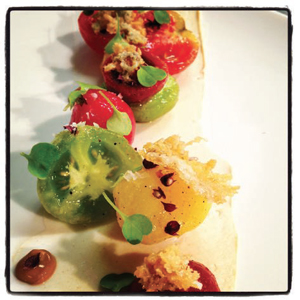
Marketing muscle may be the area that most separates the Davids from the Goliaths in the restaurant business. Smaller restaurant groups and independents simply don’t have the resources to compete with national television advertising, billboards and large-scale giveaways. But they can make up for their lack of funding with a smart strategy. Here are some effective moves that won’t break the bank.
1. Make word of mouth your best friend.
According to Nielsen, 90 percent of people trust a friend’s recommendation, and another 70 percent trust online consumer opinions. “Word of mouth is the number one way restaurants get business,” says Rob Fuggetta, author of Brand Advocates: Turning Enthusiastic Customers into a Powerful Marketing Force. His company, Zuberance, helps clients systematize their word-of-mouth building efforts. “Word of mouth can help you or kill you,” he adds.
Many restaurants use guest comment cards, but Fuggetta says too often they fail to answer one key question: “On a scale of 1 to 10, how likely are you to recommend our restaurant to a friend?” And don’t just ask the question to live guests; pose it on your website or your Facebook page.
The guests who answer 9 or 10 should become your new advocates, Fuggetta says. “It’s all about building an advocate army and continually engaging and mobilizing them,” he explains. “They serve as a volunteer marketing force.”
How can an owner tap that force? Encourage them to rate and review your restaurant, either on a landing page that’s part of your website or on a third-party site such as Yelp or Urbanspoon.
“Some companies benefit from organic word of mouth—Apple, Zappos—it just happens,” Fuggetta notes. “But most companies, including restaurants, need a system to drive word of mouth, not just leave it to chance.”
Bill Lee, author of The Hidden Wealth of Customers, agrees. “Many firms spend lots of resources pursuing outside influencers who’ve gained a following on the web and through social media,” he says. “A better approach is to find and cultivate customer influencers and give them something great to talk about online.”
Lots of people like to use this platform to post photos of their vacations or their meals, but some chefs are leveraging photography to show off their creations or share what’s going on behind the scenes. “Instagram is slower than Twitter, but faster than Facebook—the perfect pace for drooling,” says Gregory Gordet, chef at Departure in Portland, OR. Pittsburgh’s Kevin Sousa uses Instagram to provide updates from the kitchen, and the promotion has paid off: Sousa says every time he posts a photo, at least five guests come in that day and order the dish.
3. Mine the information from comment cards.
Yes, it’s old school, but comment cards serve multiple purposes. If you can get customers to fill them out, you can build a database of e-mail addresses, anniversaries, birthdays, likes, dislikes and more. Obviously the contact information can help you reach out, but knowing what people like provides a springboard for promotions, says Amy Foxwell, whose company, Win Win Restaurant Marketing, advises restaurant operators. If comments repeatedly mention something positive, say the house specialty or a particular drink, that gives you a hook that’s more likely to get attention.
4. Partner with your neighbors.
Foxwell says owners often overlook synergies they could form with local businesses. Located next door to a movie theatre? Cross-promote with the owners. Mother’s Day coming up? Create a package with the florist or the photographer for the special day. “It doesn’t cost very much, but you can tap into a whole new set of people and clients,” Foxwell says. “If you both co-market what you are doing, then you can be touching a whole new set of people.”
5. Use coupons to build awareness.
A funny thing happened to Aurelio’s, a 43-unit pizza restaurant chain, when it started posting coupons through Facebook Offers. “A lot of people would claim the offer and print it at home,” says Kirk Mauriello, the company’s director of franchising. “But only a small percentage would actually use it.” Yet during the Facebook promotion weeks, business picked up 10-11 percent.
“Getting in front of the customer early in the week, when they are making those decisions, seems to be key,” Mauriello says.
A study from coupons website BeFrugal.com found that 60 percent of consumers say they would be more loyal to restaurants that send out e-mail offers. The company also noted that after a 10-year decline, coupon purchases increased last year compared to the year before. Today, a restaurant can reach guests and potential guests through Twitter offers, website coupons, push mobile apps, text offers, e-mails and old-fashioned mailings.
See more tips

6. Don’t take existing customers for granted.
It’s accepted wisdom that keeping a steady customer is less expensive than courting a new one. One way to target current guests is by looking at sales and credit card data. Companies like Swipely offer payment technology that centralizes sales data, credit card habits, social media, loyalty programs and more. Chef Tony’s, a casual spot in Bethesda, MD, uses it to manage a loyalty program that provides rebates and other ways to keep members engaged. Swipely also tracks frequency, something Chef Tony’s owner Tony Marciante deems vital.
“If your mix is 80 percent new guests and 20 percent returning, you might want to look at ways to get people to stay,” he reasons. “We maintain an active database of our clients, and we enjoying bringing people back with creative offers,” Marciante says. “We want to make it a habit.” He also uses the data to send “welcome back” messages to lapsed customers.
7. Think about brand extensions.
Smaller operators with very popular signature items might not be equipped to become the next Wolfgang Puck or Emeril Lagasse. But a more modest private-labeling effort is a perfect way to expand your market and remind customers about your brand.
A novel way to accomplish such a brand extension is by creating a house wine. Manresa in Saratoga, CA, FT33 in Dallas and Acquerello in San Francisco are among the operations that have worked with local wineries to produce their own vintages. Often, they burnish the brand and provide value as well. “Our intention was never really to promote Acquerello,” says Gianpaolo Paterlini, the restaurant’s wine director. “Since the wines are only sold in the restaurant, the people seeing/tasting them are already dining with us....the real reason we started doing these projects was to create wines that we love to drink and that go well with our food that don’t cost a fortune.”
8. Celebrate anything.
Any restaurant can get stale, but in today’s environment, with a growing list of alternatives and shorter attention spans, stirring up interest is essential. Meal deals and specials tied to holidays are a start, but what do you do when there aren’t any popular holidays to celebrate? Create your own, Foxwell suggests. “We celebrated the chef’s birthday, our restaurant’s anniversary or my kid’s birthday party to create some buzz—and it worked,” she explains.
“The food has to be good and the service has to be good, but you also need a way to keep communicating” with your audience, Foxwell says. “People will forget about you, so you really have to keep them engaged.”
9. Don’t leave social media and websites to chance.
Facebook and Twitter, web pages, restaurant review sites all keep awareness levels high, but it’s important to control the message that users get as much as possible. Aurelio’s, for example, hired a staffer to monitor sites like Yelp and Trip Advisor to make sure criticisms are addressed and information is up-to-date. That person also makes sure that mapping sites show correct locations. And the company partnered with a third- party provider that helps ensure all 43 Facebook pages present a united front and consistent information.
10. Build a loyal fan base.
A recent study from Loyalogy, a restaurant rewards program consulting firm, suggests that consumers who belong to restaurant clubs are 25 percent more likely to visit. Programs with a clearly defined proposition that earns members points toward rewards seem to work best, as do those that encompass multiple restaurant brands. “The LoyaltyPulse study provides clear evidence directly from consumers regarding the effectiveness of restaurant rewards programs and the value associated with using the rewards program data to tailor and target guest e-mail communication,” says Dennis Duffy, the company’s president.





